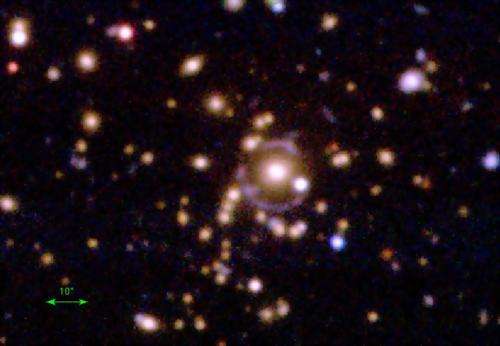A serendipitous gravitational lens

(PhysOrg.com) -- The path traveled by a light beam will bend in the presence of matter. This remarkable prediction, reached by Einstein in his theory of general relativity, was confirmed by observations of the solar eclipse of 1919. One consequence of this phenomenon is that light from a distant galaxy passing by an intervening galaxy en route to earth will be distorted, much in the way that light passing through a glass lens will be bent, sometimes deforming the appearance of objects seen through it.
Astronomers call an intervening galaxy in this role a "gravitational lens"; the object whose light is bend is called the lensed galaxy. The first such gravitationally lensed object was discovered in 1979, and since then several dozen lensed galaxies have been found. Such discoveries are difficult to make, however, because the lensed galaxies are far away, very faint, and randomly found across the sky, while there are many millions of other galaxies that, at least at first glance, appear similar.
CfA astronomer Mark Brodwin is one member of a team of scientists examining a set of images taken by a sensitive optical survey of the extragalactic sky designed to study the cosmological expansion of the universe. They discovered in one image a beautiful example of a gravitational lens in the form of a purplish ring around a galaxy. The lead author named the source "The Elliot Arc" after her nephew. Followup research found that the lensing galaxy is at a nominal distance of 4.9 billion light-years; studies of the Elliot Arc revealed that it is the distorted image of a much older and distant galaxy, located about 10.1 billion light-years away.
The scientists were further able to conclude that the closer galaxy is actually a gigantic cluster of galaxies with a combined mass of about 20,000 Milky Way galaxies. They also found that the distant galaxy appears to have much weaker star formation going on than is expected from current models - but then discoveries like this one, that push the limits of knowledge, often refine our understanding of the distant universe.
Provided by Harvard-Smithsonian Center for Astrophysics



















